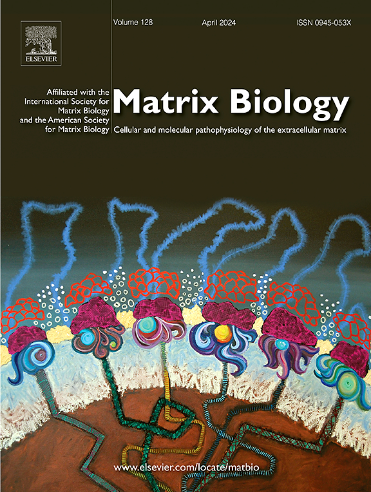PH4 - EFB在果蝇胶原脯氨酰4-羟基化中主要作用的证据。
IF 4.8
1区 生物学
Q1 BIOCHEMISTRY & MOLECULAR BIOLOGY
引用次数: 0
摘要
胶原是细胞外基质的基本组成部分,需要精确的细胞内翻译后修饰才能发挥正常功能。在这些修饰中,脯氨酰4-羟基化对稳定胶原蛋白三螺旋结构至关重要。在人类中,这种反应是由胶原脯氨酸4-羟化酶(P4Hs)介导的。虽然人类拥有三个编码这些酶的基因(P4H s),但黑胃果蝇尽管基因组简单,但至少有26个候选蛋白P4H s,而且人们对其中哪些基因实际上对果蝇的胶原蛋白起作用知之甚少。在这项研究中,我们通过进行彻底的生物信息学和生化分析来解决这个问题。我们发现在26种潜在的胶原蛋白P4H中,PH4与脊椎动物胶原蛋白P4H具有最高的同源性。此外,虽然胶原P4Hs及其底物必须存在于相同的细胞中,但我们在组织和单细胞水平上的转录组学分析显示,PH4 EFB与胶原IV基因共表达,而其他P4H相关基因则不表达。此外,在胚胎发生过程中发现PH4 EFB的表达先于胶原IV,推测PH4 EFB可以有效地修饰胶原。最后,生化分析证实PH4能与胶原结合,支持其在IV型胶原修饰中的直接作用。总的来说,我们确定PH4是果蝇中负责胶原IV生物合成的主要和潜在组成的脯氨酸4-羟化酶。我们的研究结果强调了果蝇胶原IV生物合成的非常简单的性质,这可能作为确定胶原工程最低要求的蓝图。本文章由计算机程序翻译,如有差异,请以英文原文为准。
Evidence for the major role of PH4⍺EFB in the prolyl 4-hydroxylation of Drosophila collagen IV
Collagens are fundamental components of extracellular matrices, requiring precise intracellular post-translational modifications for proper function. Among the modifications, prolyl 4-hydroxylation is critical to stabilise the collagen triple helix. In humans, this reaction is mediated by collagen prolyl 4-hydroxylases (P4Hs). While humans possess three genes encoding these enzymes (P4H⍺s), Drosophila melanogaster harbour at least 26 candidates for collagen P4H⍺s despite its simple genome, and it is poorly understood which of them are actually working on collagen in the fly. In this study, we addressed this question by carrying out thorough bioinformatic and biochemical analyses. We demonstrate that among the 26 potential collagen P4H⍺s, PH4⍺EFB shares the highest homology with vertebrate collagen P4H⍺s. Furthermore, while collagen P4Hs and their substrates must exist in the same cells, our transcriptomic analyses at the tissue and single cell levels showed a global co-expression of PH4⍺EFB but not the other P4H⍺-related genes with the collagen IV genes. Moreover, expression of PH4⍺EFB during embryogenesis was found to precede that of collagen IV, presumably enabling efficient collagen modification by PH4⍺EFB. Finally, biochemical assays confirm that PH4⍺EFB binds collagen, supporting its direct role in collagen IV modification. Collectively, we identify PH4⍺EFB as the primary and potentially constitutive prolyl 4-hydroxylase responsible for collagen IV biosynthesis in Drosophila. Our findings highlight the remarkably simple nature of Drosophila collagen IV biosynthesis, which may serve as a blueprint for defining the minimal requirements for collagen engineering.
求助全文
通过发布文献求助,成功后即可免费获取论文全文。
去求助
来源期刊

Matrix Biology
生物-生化与分子生物学
CiteScore
11.40
自引率
4.30%
发文量
77
审稿时长
45 days
期刊介绍:
Matrix Biology (established in 1980 as Collagen and Related Research) is a cutting-edge journal that is devoted to publishing the latest results in matrix biology research. We welcome articles that reside at the nexus of understanding the cellular and molecular pathophysiology of the extracellular matrix. Matrix Biology focusses on solving elusive questions, opening new avenues of thought and discovery, and challenging longstanding biological paradigms.
 求助内容:
求助内容: 应助结果提醒方式:
应助结果提醒方式:


